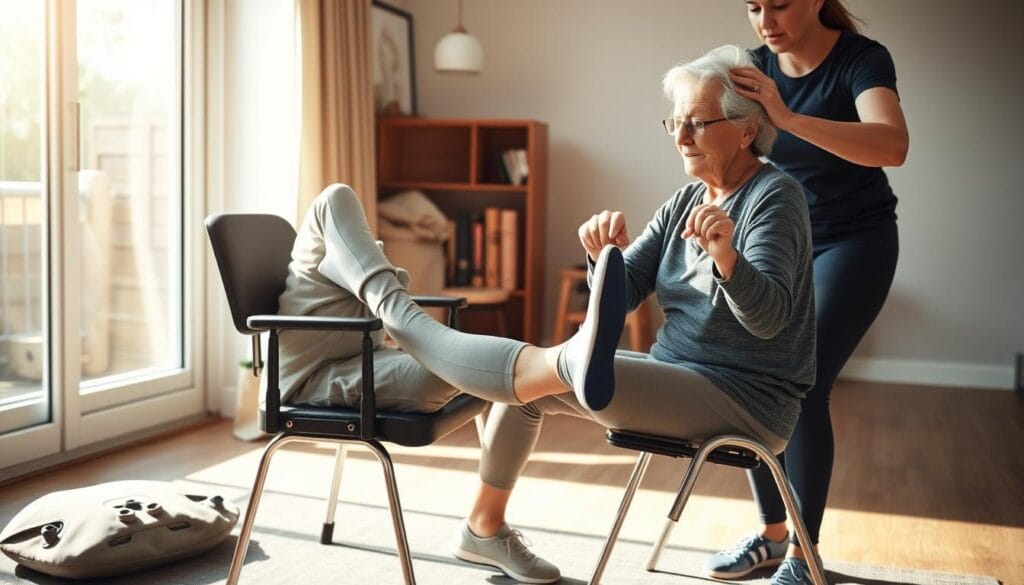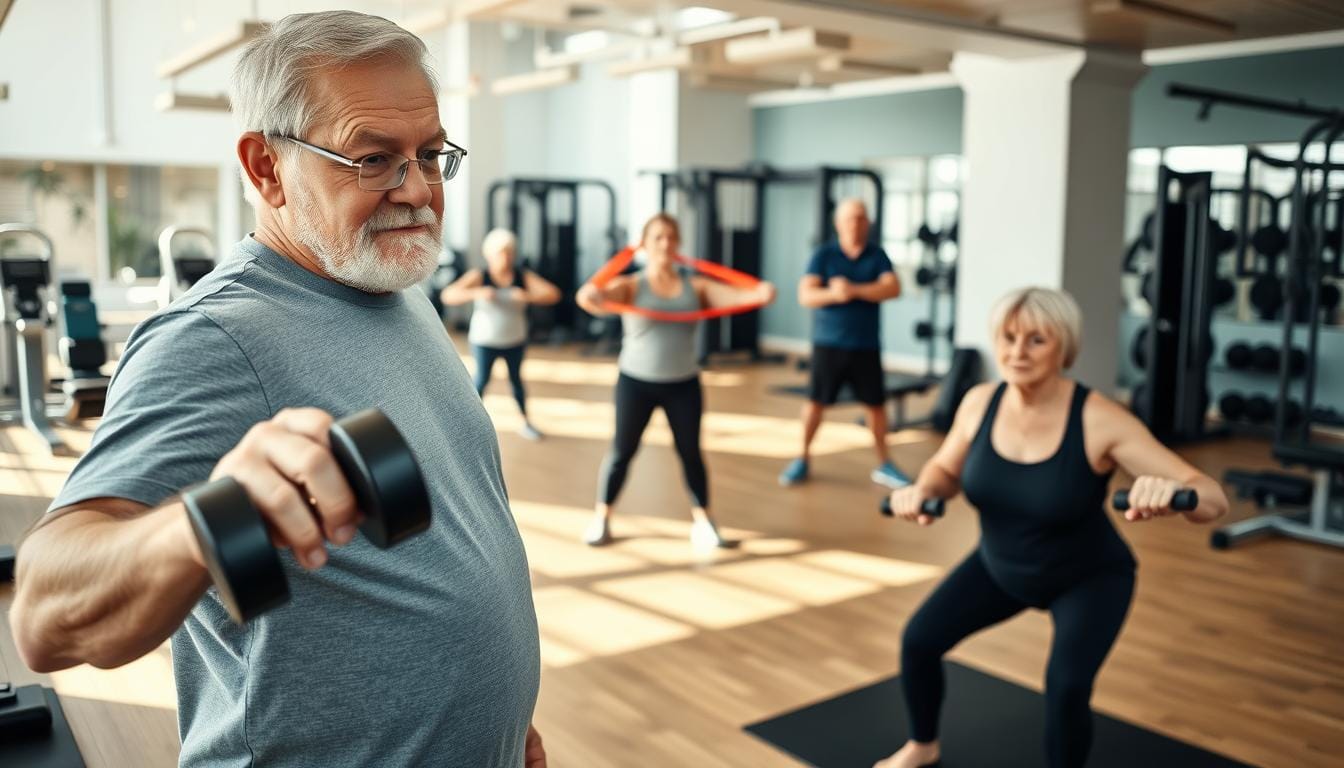As we age, staying active becomes more important than ever. Physical activity not only enhances health but also improves mobility and overall quality of life. For older adults, incorporating regular exercise can help combat age-related physical decline and boost independence.
The CDC recommends engaging in strength training at least twice a week. This type of activity helps maintain muscle mass, supports bone density, and reduces the risk of falls. Programs like SilverSneakers offer guided classes, both in-person and online, making it easier to get started in a supportive community.
For beginners, safety and gradual progression are key. This guide focuses on simple, accessible exercises that prioritize proper form and adaptation. Whether you’re new to resistance activities or returning after a break, taking the first step can lead to lasting benefits for your fitness and well-being.
Key Takeaways
- Regular physical activity improves health and mobility in older adults.
- The CDC suggests strength training twice weekly for seniors.
- SilverSneakers provides guided classes and community support.
- Safety and gradual progression are essential for beginners.
- Simple exercises can enhance independence and quality of life.
Why Strength Training for Seniors is Essential
Physical activity plays a key role in healthy aging. As people grow older, maintaining muscle mass and bone health becomes increasingly important. Without regular exercise, the body naturally loses muscle, a condition known as sarcopenia. This can lead to reduced mobility and independence.
Resistance activities, such as lifting weights or using resistance bands, help combat sarcopenia. They also improve bone mineral density, reducing the risk of osteoporosis. Stronger bones and muscles make daily tasks easier and safer for older adults.
Falls are a major concern for many people as they age. Studies show that resistance exercises can reduce fall risk by up to 30%. These activities enhance balance and coordination, making it easier to stay steady on your feet.
Beyond physical benefits, regular exercise also supports brain health. Engaging in resistance activities has been linked to slower progression of cognitive decline. This includes a reduced risk of dementia and improved mental clarity.
In contrast, sedentary lifestyles can accelerate muscle loss and weaken bones. Staying active helps maintain overall health and quality of life. The benefits of regular physical activity extend far beyond the gym, impacting every aspect of daily living.
Benefits of Strength Training for Seniors
Engaging in resistance exercises can unlock numerous benefits for older individuals. These activities improve mobility, making daily tasks like climbing stairs or carrying groceries easier. Studies show that functional mobility increases by 12-14% with regular resistance activities.
Beyond physical improvements, these exercises also support mental health. Research indicates a 30-50% reduction in symptoms of depression. The release of endorphins during exercise enhances mood and promotes a sense of well-being.
Improved balance is another key advantage. Resistance exercises strengthen the muscles in the legs and core, reducing the risk of falls. Better balance leads to greater confidence and independence in daily life.
Metabolic health also sees significant improvements. Resistance activities enhance glucose metabolism, aiding in weight management. This can lower the risk of chronic conditions like diabetes.
Compound movements, such as squats or lunges, boost cardiovascular health. These exercises engage multiple muscle groups, improving heart efficiency and circulation. Stronger muscles also support joint stability, easing symptoms of arthritis.
Incorporating resistance exercises into your routine is a practical way to stay active. Strengthening the arms, legs, and core can transform the way you experience daily life. The benefits extend far beyond physical health, enhancing overall quality of life.
Getting Started with Strength Training
Mastering basic movements before adding weights is a safe and effective approach. According to fitness expert Gavin McHale, beginners should focus on bodyweight exercises to build a strong foundation. This ensures proper form and reduces the risk of injury.
Start with 3 sets of 10-15 reps for each exercise. Controlled movement is key to maximizing benefits. Always return to the starting position after each repetition to maintain alignment and stability.
Understanding key terms is essential for success. A set refers to a group of repetitions, while reps are the number of times you perform an exercise. Tempo describes the speed of each movement, and rest intervals are the breaks between sets.
Here’s a 4-week progression plan to help you build confidence and strength:
| Week | Activity | Progression |
|---|---|---|
| 1 | Bodyweight squats, wall push-ups | Focus on form and consistency |
| 2 | Bodyweight lunges, modified planks | Increase reps by 2-3 per set |
| 3 | Light dumbbells (3-5 lbs), step-ups | Add resistance gradually |
| 4 | Weighted squats, resistance band rows | Combine bodyweight and resistance training |
Certified trainers, such as those at the Hospital for Special Surgery, recommend tracking progress in an exercise journal. This helps monitor improvements and prevents overexertion. Regular assessments ensure you’re on the right path.
By following this plan, you’ll build strength and confidence. Gradual progression is the key to long-term success in resistance training.
Essential Strength Training Exercises for Seniors
Incorporating simple exercises into daily routines can significantly enhance physical well-being. These activities focus on improving mobility, stability, and overall health. Below are foundational moves designed for older adults, emphasizing safety and proper form.
Chair-assisted squats are an excellent starting point. Begin by sitting on a sturdy chair, then stand up slowly while keeping your chest forward and hips back. Aim for 5 repetitions to strengthen the legs and improve balance.

Wall press-ups are another effective exercise. Stand facing a wall, place your hands at shoulder height, and push your body away. Perform 3 sets of 5-10 repetitions to engage the shoulders and back muscles.
For upper body strength, try resistance band rows. Secure a band to a sturdy object, hold the ends, and pull toward your chest. Complete 2 sets of 8-12 repetitions to strengthen the back and improve posture.
Seated bicep curls using water bottles are a joint-friendly option. Hold a bottle in each hand, bend your elbows, and lift the bottles toward your shoulders. Perform 3 sets of 5 repetitions per arm.
Modified push-ups against a wall or counter are ideal for shoulder stability. Keep your body straight and lower yourself toward the surface, then push back up. This exercise is gentle on the knees and hips.
Bird-dog exercises enhance core strength and balance. Start on all fours, extend one arm and the opposite leg, and hold for a few seconds. Complete 8-10 repetitions per side to improve coordination.
Alternatives like resistance bands or light dumbbells provide flexibility for those with joint concerns. These tools allow for gradual progression while minimizing strain on the knees and hips.
By incorporating these exercises into your routine, you can build strength, improve mobility, and enhance overall well-being. Always prioritize proper form and consult a professional if needed.
Safety Tips for Strength Training
Prioritizing safety during physical activity ensures long-term health and prevents injuries. Proper techniques and awareness of warning signs are essential for a safe and effective routine.
Watch for red flags like sharp joint pain, dizziness, or breathlessness. These symptoms signal the need to stop immediately and seek guidance. Ignoring them can lead to serious harm.
Allow 48-hour recovery periods between sessions. This prevents overtraining and reduces muscle soreness. Rest is crucial for muscle repair and growth.
Maintain a neutral spine during exercises to protect your back. Avoid arched backs, especially during overhead presses. Proper posture minimizes strain on the spine.
Engage your core before moving limbs. This stabilizes your body and reduces the risk of injury. Proper lifting mechanics are key to safe workouts.
Prepare your workout space by removing tripping hazards. Ensure chairs and equipment are stable. Use yoga mats for knee comfort on hard floor surfaces.
“Start with 10-15 minute sessions; scale intensity gradually,” advises Tiffany Chag, a certified fitness trainer. This approach builds endurance without overwhelming the body.
Here’s a quick reference table for safety tips:
| Focus Area | Safety Tip |
|---|---|
| Posture | Maintain a neutral spine; avoid arched backs. |
| Recovery | Rest 48 hours between sessions. |
| Workout Space | Remove tripping hazards; use yoga mats. |
| Warning Signs | Stop if you feel sharp pain or dizziness. |
| Core Engagement | Engage core before moving limbs. |
By following these guidelines, you can enjoy the benefits of physical activity while minimizing risks. Safety is the foundation of a sustainable routine.
Creating a Strength Training Routine
Building a consistent routine is the best way to achieve long-term health goals. A well-structured workout plan ensures progress while minimizing the risk of injury. Start with a 25-minute session that includes a 5-minute warm-up, 15-minute strength block, and 5-minute cool-down stretches.
For beginners, a 2-day/week template with upper and lower body splits is ideal. This approach allows for adequate recovery while targeting all major muscle groups. For example, focus on upper body exercises like wall press-ups on Day 1 and lower body moves like chair-assisted squats on Day 2.
Integrate balance work into rest intervals to maximize efficiency. Single-leg stands or heel-to-toe walks can improve stability without adding extra time to your routine. These small additions enhance overall coordination and reduce fall risk.
Periodization is key to continuous improvement. Gradually increase weights by 5% every 3-4 weeks to challenge your muscles. Track progress in a journal to monitor sets, reps, and any changes in resistance.
SilverSneakers LIVE offers guided sessions for those seeking structured support. These classes provide expert guidance and a sense of community, making it easier to stay motivated.
Pair workout days with light cardio, such as walking, for balanced activity. This combination improves cardiovascular health while complementing your strength routine. Consistency and gradual progression are the foundations of a successful plan.
Equipment and Space for Strength Training
Setting up a safe and effective workout environment is crucial for success. The right equipment and adequate space ensure comfort and reduce the risk of injury. Whether you’re using dumbbells, resistance bands, or household items, proper setup enhances your routine.
Here’s a comparison of common equipment options:
| Equipment | Cost | Benefits |
|---|---|---|
| Resistance Bands | $15 | Portable, versatile, and joint-friendly. |
| Adjustable Dumbbells | $100+ | Customizable weights for progression. |
For those on a budget, household items like water bottles (16-20 oz) can serve as 3-5 lb weights. Canned goods or towels can also be used for hand weights or sliders. These DIY alternatives are cost-effective and accessible.
Space requirements are minimal. A 6×6 ft area allows safe movement for most exercises. Ensure the area is free of tripping hazards and has a stable surface. Foldable mats are ideal for floor work, providing cushioning for your feet and knees.
Chair selection is equally important. Choose an armless chair with a non-slip base and a seat height of 17-19 inches. This ensures stability and proper posture during seated exercises.
“Grip aids like wrist wraps can make exercises more comfortable, especially for those with arthritis,” advises a certified fitness trainer.
By investing in the right tools and organizing your space, you can create a workout environment that supports your goals. Simple adjustments, like using a sturdy chair or grip aids, can make a significant difference in your routine.
Conclusion
Maintaining an active lifestyle is a powerful way to enhance long-term health and mobility. Studies show that individuals who adhere to structured programs for six months retain 40% greater mobility compared to sedentary peers. Consistency is key to unlocking these benefits.
Start small and build gradually. Adding one new exercise weekly helps avoid overwhelm and ensures steady progress. Programs like SilverSneakers, often covered by Medicare, provide guided support and a sense of community.
Safety remains a priority. Regular form checks, proper hydration, and scheduled rest days are essential for sustainable progress. Remember, strength training is a lifelong journey, not a destination.
By committing to consistency and gradual progression, you can improve your quality of life and maintain independence. Small steps today lead to significant rewards tomorrow.
FAQ
What are the best exercises for beginners?
Simple movements like chair squats, wall push-ups, and leg lifts are ideal for beginners. These focus on improving mobility and building foundational muscle without overexertion.
How often should seniors engage in physical activity?
Experts recommend at least two to three sessions per week. Consistency is key to maintaining health, improving balance, and enhancing overall fitness.
Is resistance training safe for older adults?
Yes, when done correctly. Start with light weights or bodyweight exercises, focus on proper form, and consult a healthcare provider if you have concerns.
What equipment is needed for a home workout?
Basic items like dumbbells, resistance bands, and a sturdy chair are sufficient. These tools support a variety of exercises targeting different muscle groups.
How can seniors improve balance through exercise?
Incorporate movements like single-leg stands or heel-to-toe walks. These activities enhance stability and reduce the risk of falls.
What are the benefits of regular physical activity for older adults?
It boosts muscle mass, improves bone density, enhances mobility, and supports mental health. Staying active also promotes independence and a better quality of life.
How can I ensure safety during workouts?
Warm up before starting, use proper form, avoid overloading weights, and listen to your body. If discomfort occurs, stop and seek guidance.
Can strength exercises help with chronic conditions?
Yes, they can manage symptoms of arthritis, osteoporosis, and diabetes. Always consult a healthcare professional to tailor exercises to your needs.





